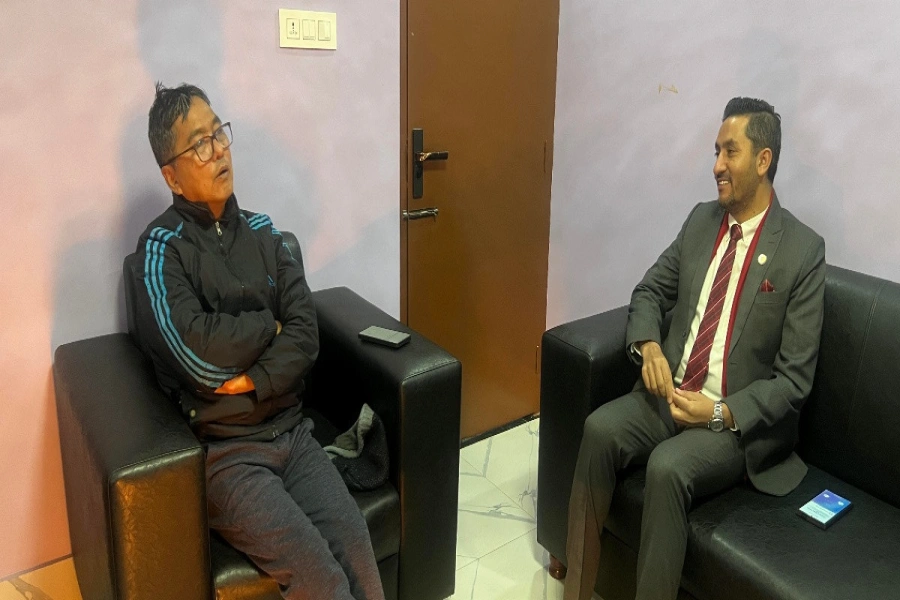There are no exact statistics, but over 60 percent of the tourists who land at the Kathmandu airport visit Pokhara. There would certainly be a further increase in the number of tourists in Pokhara after the Pokhara Regional International Airport (PRIA) comes into operation.
Pokhara is not only the most popular tourism destination in Nepal but is also considered as the tourism capital of the country. The city sprawls on the shores of Phewa Lake. The Annapurna Range, with three out of the ten highest peaks in the world — Dhaulagiri, Annapurna [1] and Manaslu — is within 15–35 miles of the Pokhara Valley. Pokhara’s enthralling beauty has been the subject of many travel writers. Its pristine air, the eye-catching scenery of the snowy peaks and the clear Phewa, Begnas and Rupa lakes, put together, make this destination ‘the Jewel of the Himalayas.’
Each year, tourists in big numbers from all over the world visit Pokhara to enjoy the beauty of the mountains, lakes, and surrounding destinations. They come to Pokhara for adventure, historical, and recreational or leisure purposes and there are unlimited possibilities that the international community finds here for the sake of study, religion, health, sports, mission, seminar, and business trips as well.
After the opening of Pokhara Regional International Airport (PRIA), it is expected to increase the number of tourists in Pokhara and the surrounding areas. The airport will officially come into operation from January 1, 2023. It will be the 3rd international airport in Nepal. In 2013, the Civil Aviation Authority of Nepal (CAAN) signed an agreement with China CAMC Engineering for the construction of this airport. The construction of the airport started in April 2016 with an estimated cost of US$216 million under a loan from the Exim Bank of China.
The airport is expected to handle one million passengers per year. The airport has a single 2,500 m (8,200 ft) long runway with a width of 45 meters and it is built to the category 4D standard. The international apron at this airport can handle up to three narrow body aircraft with two aerobridge facilities, while the aprons at the domestic terminal are able to accommodate up to eight aircraft: four ATR-72 size turboprops and four smaller STOL aircraft. The airport also has a 6,000m² domestic and international hangar.
Aero Thai conducted successful calibration flights for a week starting from 21st Nov 2022 for at this airport, which is done to inspect the communication or navigational instruments to ensure that they work accurately and precisely. The Ritthepani hill has been flattened by 12 meters before calibration flights and the height of the hill will be further flattened by 40 meters for smooth takeoff and landing of aircraft.
Airline companies making business plan for Pokhara Regional Int...
_20220508065427.jpg)
The Nepal government had an estimate of USD 180 million to build this airport but the Chinese side, while bidding for the airport, proposed USD 305 million at the minimum. However, the cost was finally settled at USD 216 million, which was still higher than the government estimation.
The Gautam Buddha International Airport of the same quality has been built for USD 75 million. Thus, it seems that the Chinese loan came for PRIA by inflating the cost. Moreover, the average interest rate for loans given by multilateral agencies is 1.5 percent at the maximum, and commercial loan interest rates cross 2 percent, but the average interest rate of Chinese loans to this airport is at 4 percent.
According to Fitch Solutions (a British Company), Chinese investments will be a strong driver of growth in Nepal over the coming years. And Chinese-led infrastructure projects and strong Chinese tourist arrivals underpin stronger economic momentum in Nepal over the coming decade. However, an overreliance on China brings with it the risk of falling into a debt trap.
The overestimation and high interest rates of the loan to build PRIA has been a subject of big debate in Nepal. However, Nepal cannot ignore Chinese investments, especially the BRI projects, as it has already signed an initial agreement with China. Nepal certainly learned a lesson, due to unusual loan conditions of this project, on how to further negotiate investment modalities, interest rates, debt burdens and other issues for future projects under BRI.
There are no exact statistics, but out of the total tourists who arrive at the Kathmandu airport, more than 60 percent visit Pokhara. There would certainly be a further increase in the number of tourists in Pokhara, after the full operation of this airport. Thereafter it would start generating revenue at a satisfactory level. However, a high rate of Chinese loans could be a subject of debt burden for Nepal to repay it.
Currently, flights could be operated easily from countries of South Asia and Southeast Asia to this airport because Nepal has only one air entry point from Simra. However, flying from the Middle East and India to this airport could be costly due to India’s refusal to grant western air entry points to Nepal.
Pokhara has been a preferred destination for Indian tourists and this airport will, most possibly, link to important cities of India by both Nepali and Indian airlines. Buddha Air has already announced plans to fly to Varanasi, and if India permits a western air route, it will also operate flights to New Delhi and Dehradun from this airport through ATR 72 aircraft.
Similarly, another private airline, Shree Airlines, is also preparing to start medical and chartered flights connecting Pokhara to India and Bangladesh through Bombardier aircraft. As PRIA has been constructed for narrow-body Boeing or Airbus equivalent aircraft and until aircraft of such capacities are not being operated in this airport, it may not fulfill the objectives of constructing this airport.
However, Buddha Air has also a long-term plan to operate its international fleet of Boeing or Airbus aircraft at PRIA. Moreover, the airline plans to construct a hangar that can accommodate aircraft up to the size of an Airbus A319.
In mid-2021, Biman Bangladesh Airlines was the first international carrier to plan to serve the airport upon opening. Some other airlines have also shown interest in operating flights to and from PRIA and a few countries have already revised bilateral air services agreements with Nepal to operate flights out of the Kathmandu-based international airport including 21 flights from China.
Pokhara is also a priority destination for Chinese tourists. Currently, about half a dozen Chinese airlines regularly fly to Kathmandu and some of them would expect to directly fly to Pokhara from China. According to the Chinese media, Chinese tourists are set to increase over the coming years after PRIA comes into operation.
Nowadays, the business size of global tourism equals or even exceeds that of oil exports, food products or automobiles. Tourism has become one of the major players in international commerce and characterizes at the same time one of the primary income sources for many developing countries. This progress goes hand in hand with a growing diversification and competition among destinations. And among others, the aviation policy should be formed in such a way that it is supportive to the tourism industry as well as economic development of the nation.
As tourism is consumed at the point of production, it gives local businesses and communities the opportunity to benefit by selling goods and services directly to the visitors at the destinations. This airport would help support the growth of the economy of Pokhara and Gandaki Province as a whole.
(Shrestha is a former Under Secretary at the Ministry of Finance, Nepal, and is currently associated with UNDP Africa)


-1200x560_20220416172859.jpg)
































